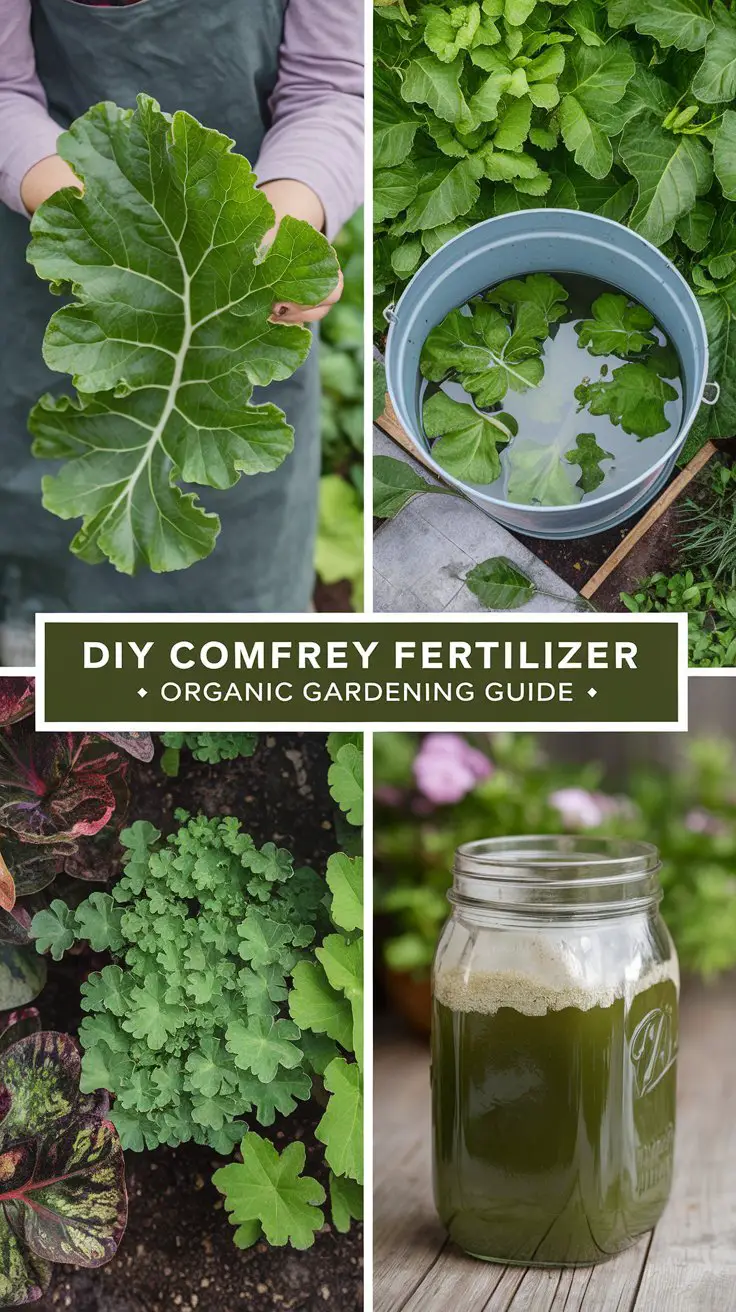Discover how to make nutrient-rich comfrey fertilizer at home. Our step-by-step guide covers growing comfrey, creating liquid feed, and composting methods. Perfect for organic gardeners seeking sustainable solutions.
Comfrey fertilizer is a nutrient-rich, organic solution that can dramatically improve plant growth and soil health. This guide will walk you through the process of making your own comfrey fertilizer, from growing the plant to applying the final product. Learn how to harness the power of this remarkable plant for a more sustainable and productive garden.
As an organic farming consultant with over two decades of experience, I’m excited to share my expertise on creating and using comfrey fertilizer. Let’s dive into the world of this remarkable plant and its benefits for your garden!
Why Use Comfrey as Fertilizer?

Before we get into the how-to, let’s consider the benefits of comfrey fertilizer:
- Rich in potassium, phosphorus, and calcium
- Promotes strong root development and flower production
- Improves soil structure and microbial activity
- Sustainable and cost-effective
- Reduces reliance on synthetic fertilizers
Now, let’s explore the process of making comfrey fertilizer step by step.
Step-by-Step Guide to Making Comfrey Fertilizer
1. Growing Comfrey
Why It’s Important: Having your own comfrey patch ensures a steady supply for fertilizer production.
How to Do It:
- Choose a sunny to partially shaded location.
- Plant comfrey roots or crown cuttings in spring or fall.
- Space plants 2-3 feet apart.
- Water regularly until established.
2024 Trend: Polyculture gardening is gaining popularity, with comfrey often used as a support plant in diverse garden ecosystems.
Pro Tip: Opt for sterile varieties like Bocking 14 to prevent invasive spread.
2. Harvesting Comfrey Leaves
Why It’s Important: Proper harvesting ensures sustainable growth and optimal nutrient content.
How to Do It:
- Cut leaves when the plant is 2 feet tall, leaving a few inches above the ground.
- Harvest up to 4-5 times per growing season.
- Use gloves to avoid skin irritation from the bristly leaves.
2024 Update: New studies suggest that harvesting in the morning may increase the nutrient concentration in the leaves.
Pro Tip: Rotate your harvesting among multiple plants to prevent overexploitation.
3. Making Comfrey Liquid Fertilizer
Why It’s Important: Liquid fertilizer is fast-acting and easily absorbed by plants.
How to Do It:
- Fill a bucket 2/3 full with chopped comfrey leaves.
- Add water to cover the leaves.
- Cover the bucket and let it steep for 3-4 weeks.
- Strain the liquid and dilute 1:10 with water before use.
2024 Innovation: Solar-powered aerators are becoming popular for reducing odor during the steeping process.
Pro Tip: Use rainwater for steeping to avoid chlorine and other chemicals found in tap water.
4. Creating Comfrey Compost Accelerator
Why It’s Important: Comfrey can speed up the composting process and enrich your compost.
How to Do It:
- Chop fresh comfrey leaves.
- Add them in layers to your compost pile.
- Aim for a ratio of 1 part comfrey to 3 parts other compost materials.
2024 Trend: Bokashi composting systems are incorporating comfrey for enhanced fermentation.
Pro Tip: Combine comfrey with high-carbon materials like straw or wood chips for a balanced compost mix.
5. Making Comfrey Mulch
Why It’s Important: Comfrey mulch suppresses weeds and slowly releases nutrients into the soil.
How to Do It:
- Spread freshly cut comfrey leaves around plants.
- Apply a layer 2-3 inches thick.
- Replenish as the leaves decompose.
2024 Research: Studies are exploring the potential of comfrey mulch in suppressing soil-borne pathogens.
Pro Tip: Use comfrey mulch around heavy feeders like tomatoes and squash for best results.
6. Brewing Comfrey Tea
Why It’s Important: Comfrey tea is a quick and easy way to make a nutrient-rich foliar spray.
How to Do It:
- Fill a bucket 1/4 full with fresh comfrey leaves.
- Add boiling water and let steep for 24 hours.
- Strain and dilute 1:10 with water before spraying on plants.
2024 Update: New research suggests adding seaweed extract to comfrey tea for enhanced micronutrient content.
Pro Tip: Apply comfrey tea in the early morning or late evening for best absorption.
7. Drying Comfrey for Long-Term Storage
Why It’s Important: Dried comfrey can be used year-round, even when fresh leaves aren’t available.
How to Do It:
- Harvest leaves on a dry, sunny day.
- Spread leaves in a single layer on drying racks or hang in bunches.
- Store dried leaves in airtight containers in a cool, dark place.
2024 Innovation: Energy-efficient solar dehydrators are gaining popularity for herb and leaf drying.
Pro Tip: Crumble dried leaves and mix with water to make a quick fertilizer solution.
Best Practices for Using Comfrey Fertilizer
To get the most out of your comfrey fertilizer:
- Apply liquid fertilizer every 2-4 weeks during the growing season.
- Use comfrey fertilizer in conjunction with other organic gardening practices for best results.
- Avoid using comfrey fertilizer on young seedlings, as it may be too strong.
- Rotate comfrey plantings every few years to prevent nutrient depletion in the soil.
- Always dilute liquid comfrey fertilizer to prevent burning plants.
Embracing Natural Fertilizers
Making and using comfrey fertilizer is a rewarding practice that can significantly improve your garden’s health and productivity while reducing your environmental impact. By harnessing the power of this remarkable plant, you’re joining a community of gardeners committed to sustainable and organic practices.
Remember, creating the perfect comfrey fertilizer may take some experimentation. Don’t be afraid to adjust your methods based on your plants’ responses and your specific garden conditions.
For more information on organic gardening and natural fertilizers, visit resources like the Organic Materials Review Institute or your local cooperative extension service. Happy gardening, and may your plants thrive with the power of comfrey!
For more gardening tips and plant care guides, visit usagardenhub.com.




2 Comments on “How To Make Comfrey Fertilizer : A Complete Guide for Organic Gardeners”